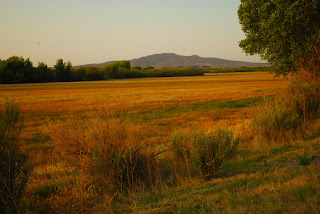 |
The taming of free flowing rivers by means of dams and controlled releases of water becomes necessary when large numbers of people build homes and workplaces on the floodplains of such rivers. But the result of these large scale engineering projects can have negative as well as positive consequences. Problems often develop when one or more of the river's functions, such as scouring its own channel to make room for new vegetation, is prevented or impeded.
Because much of New Mexico is arid or semi-arid, the state has had little choice but to manage its rivers closely. Since 1939, the state and U.S. governments have worked together to reduce the negative impact of these alterations on the Rio Grande to improve the riparian aspects of river life and preserve the river's ability to serve as a refuge for wildlife.
 |
| Sunrise at El Bosque |
The most ambitious and largest project of this type is the Bosque del Apache National Wildlife Refuge. A 90 square mile section of the Rio Grande south of the city of Socorro had once been a major wintering spot for large migratory birds. Because of water control measures upstream, its marshes had become silted over and thick brush covered much of the river's causeway. The area was in danger of becoming inhospitable to wintering birds for hundreds of years. The goal of the Bosque del Apache project is to gain control of all aspects of the environment through interventions that mimic those of nature. These efforts include cleaning the river's channels by removing plant life that is not native to the area, removing sand bars and other obstructions, and in every way making the marshes attractive to birds and animals. Part of the refuge has been set aside as farmland where grains of various types are cultivated to provide food for migratory birds.
 |
| Sites along the tour route |
The results of this aggressive approach to park management have been striking. Where once migratory bird populations had dwindled to mere dozens of birds, today thousands of ducks, bald eagles, cranes and geese winter here. Throughout the winter months the park teems with birds and local animals. In short, an entire ecosystem has been rescued. Once they winter here for the first time the birds appear to look upon the human visitors as part of the environment.
Over the seventy years it has been in existence, the Bosque del Apache Wildlife Refuge has shown that people can be helpful to nature in maintaining the balance of complex systems. Riparian systems must accommodate the needs of resident wildlife as well as visiting birds. The needs of all species are similar. They include food, shelter, and security. They also include the need for continuity and pacing of life's various stages: mating, birthing and raising of the young. In all of these areas Bosque del Apache has succeeded in emulating a healthy ecosystem that now attracts more migratory birds than it did half a century ago. Our visit to this segment of the Rio Grande took place in July when there are few large birds in the refuge. Most have gone home and will not return until the winter. Nonetheless, a drive through the park was instructive.We look forward to a return visit in midwinter.


























